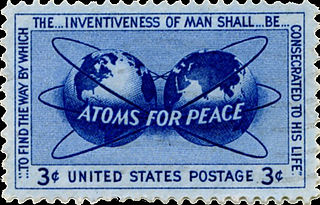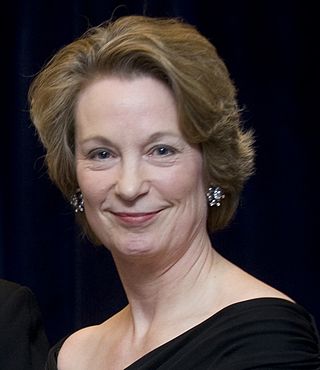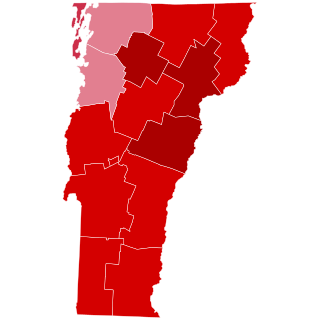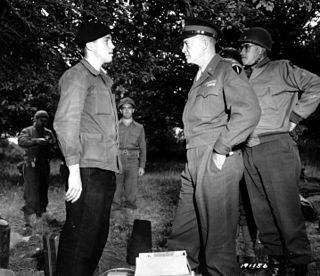Related Research Articles

Dwight David Eisenhower, nicknamed Ike, was an American military officer and statesman who served as the 34th president of the United States from 1953 to 1961. During World War II, he was Supreme Commander of the Allied Expeditionary Force in Europe and achieved the five-star rank as General of the Army. Eisenhower planned and supervised two of the most consequential military campaigns of World War II: Operation Torch in the North Africa campaign in 1942–1943 and the invasion of Normandy in 1944.

"Atoms for Peace" was the title of a speech delivered by U.S. President Dwight D. Eisenhower to the UN General Assembly in New York City on December 8, 1953.
I feel impelled to speak today in a language that in a sense is new—one which I, who have spent so much of my life in the military profession, would have preferred never to use. That new language is the language of atomic warfare.

The New Look was the name given to the national security policy of the United States during the administration of President Dwight D. Eisenhower. It reflected Eisenhower's concern for balancing the Cold War military commitments of the United States with the nation's financial resources. The policy emphasised reliance on strategic nuclear weapons as well as a reorganisation of conventional forces in an effort to deter potential threats, both conventional and nuclear, from the Eastern Bloc of nations headed by the Soviet Union.

Dwight D. Eisenhower's tenure as the 34th president of the United States began with his first inauguration on January 20, 1953, and ended on January 20, 1961. Eisenhower, a Republican from Kansas, took office following his landslide victory over Democratic nominee Adlai Stevenson in the 1952 presidential election. Four years later, in the 1956 presidential election, he defeated Stevenson again, to win re-election in a larger landslide. Eisenhower was limited to two terms and was succeeded by Democrat John F. Kennedy, who won the 1960 presidential election.

Susan Elaine Eisenhower is an American consultant, author, and expert on international security, space policy, energy, and relations between the Russian Federation and the United States of America. She is the daughter of John Eisenhower and the granddaughter of President Dwight D. Eisenhower.

| label6 = Reporting | data6 = as of {{{last_update}}} {{{time_zone}}} }}
The 1956 State of the Union Address was delivered by Dwight D. Eisenhower, the 34th president of the United States, on Friday, January 5, 1956, to both houses of the 84th United States Congress in written format. Eisenhower did not deliver a speech before a joint session of Congress because he had suffered a major heart attack four months prior and was recovering in Key West, Florida. Instead, Eisenhower opted to pre-record remarks from his office at the Naval Air Station in Key West summarizing his State of the Union Address which were broadcast to the nation in the evening on January 5.
The 1960 State of the Union Address was given on Thursday, January 7, 1960, by Dwight D. Eisenhower, the 34th president of the United States, to a joint session of the 86th United States Congress. He said, "We must strive to break the calamitous cycle of frustrations and crises which, if unchecked, could spiral into nuclear disaster; the ultimate insanity." It was the height of the Cold War, and both the Soviet Union and the United States had a responsibility to the world.
The United States foreign policy of the Dwight D. Eisenhower administration, from 1953 to 1961, focused on the Cold War with the Soviet Union and its satellites. The United States built up a stockpile of nuclear weapons and nuclear delivery systems to deter military threats and save money while cutting back on expensive Army combat units. A major uprising broke out in Hungary in 1956; the Eisenhower administration did not become directly involved, but condemned the military invasion by the Soviet Union. Eisenhower sought to reach a nuclear test ban treaty with the Soviet Union, but following the 1960 U-2 incident the Kremlin canceled a scheduled summit in Paris.

The June 6, 1944, order of the day was issued by Supreme Commander of the Allied Expeditionary Force General Dwight D. Eisenhower to Allied forces on the eve of D-Day, the first day of the invasion of Normandy. The message was intended to impress upon the troops the importance of their mission which Eisenhower called a "Great Crusade". Eisenhower had been drafting the order since February 1944 and recorded a spoken version on May 28, that was broadcast on British and American radio on D-Day.

The "People of Western Europe" speech was made by Supreme Commander of the Allied Expeditionary Force General Dwight D. Eisenhower in the run-up to the invasion of Normandy in 1944. Addressed to the people of occupied Europe it informed them of the start of the invasion and advised them on the actions Eisenhower wanted them to take. It also addressed the Allies' plans for post-liberation government.
The 1923 State of the Union Address was given by Calvin Coolidge, the 30th president of the United States, on Thursday, December 6, 1923, to the 68th United States Congress in the chamber of the United States House of Representatives. It was Coolidge's first State of the Union Address and his first speech to a joint session of the United States Congress after assuming the presidency upon the death of Warren G. Harding four months earlier in 1923. Presiding over this joint session was House speaker Frederick H. Gillett, accompanied by President pro tempore Albert B. Cummins, in his capacity as the acting president of the Senate since the office of Vice President was vacant.
The 1969 State of the Union Address was given by Lyndon B. Johnson, the 36th president of the United States, on Tuesday, January 14, 1969, to the 91st United States Congress in the chamber of the United States House of Representatives. It was Johnson's sixth and final State of the Union Address. Presiding over this joint session was House speaker John W. McCormack, accompanied by Vice President Hubert Humphrey, in his capacity as the president of the Senate.
The first 1961 State of the Union Address was delivered in written format by outgoing president Dwight D. Eisenhower, the 34th president of the United States, on Thursday, January 12, 1961, to the 87th United States Congress. It was Eisenhower's ninth and final State of the Union Address.
The 1959 State of the Union Address was given by Dwight D. Eisenhower, the 34th president of the United States, on Friday, January 9, 1959, to the 86th United States Congress in the chamber of the United States House of Representatives. It was Eisenhower's seventh State of the Union Address. Presiding over this joint session was House speaker Sam Rayburn, accompanied by Vice President Richard Nixon, in his capacity as the president of the Senate. The speech was broadcast by radio and television.
The 1958 State of the Union Address was given by Dwight D. Eisenhower, the 34th president of the United States, on Thursday, January 9, 1958, to the 85th United States Congress in the chamber of the United States House of Representatives. It was Eisenhower's sixth State of the Union Address. Presiding over this joint session was House speaker Sam Rayburn, accompanied by Vice President Richard Nixon, in his capacity as the president of the Senate.
The 1957 State of the Union Address was given by Dwight D. Eisenhower, the 34th president of the United States, on Thursday, January 10, 1957, to the 85th United States Congress in the chamber of the United States House of Representatives. It was Eisenhower's sixth State of the Union Address. Presiding over this joint session was House speaker Sam Rayburn, accompanied by Vice President Richard Nixon, in his capacity as the president of the Senate. The speech was broadcast live over both radio and television.
The 1954 State of the Union Address was given by Dwight D. Eisenhower, the 34th president of the United States, on Thursday, January 7, 1954, to the 83rd United States Congress in the chamber of the United States House of Representatives. It was Eisenhower's second State of the Union Address. Presiding over this joint session was House speaker Joseph W. Martin Jr., accompanied by Vice President Richard Nixon, in his capacity as the president of the Senate. This address was broadcast live on both radio and television.
The February 1953 State of the Union Address was given by newly inaugurated president Dwight D. Eisenhower, the 34th president of the United States, on Monday, February 2, 1953, to the 83rd United States Congress in the chamber of the United States House of Representatives. It was Eisenhower's first State of the Union Address. Presiding over this joint session was House speaker Joseph W. Martin Jr., accompanied by recently inaugurated Vice President Richard Nixon in his capacity as the president of the Senate. This address was broadcast live on both radio and television.
References
- ↑ "Today's Television Highlights". Newsday. Hempstead, New York. January 5, 1955. p. 64. Retrieved March 14, 2024.
ABC, CBS, NBC, and DuMont televise President Eisenhower's State of the Union message at 12:30 PM tomorrow.
- ↑ Edson, Arthur (January 7, 1955). "General Who Lost Political Battle Enters Enemy Camp". Daily Press. Newport News, Virginia. p. 1. Retrieved March 14, 2024.
At 12:31 P. M. today the House doorkeeper, William N. 'Fishbait' Miller, hurried down the center aisle of the House, paused and announced: 'The President of the United States.' And the general [Eisenhower] who had lost a political war [1954 midterm elections] smilingly advanced into the camp of the enemy to talk of the state of the union.
- 1 2 3 "Speeches". Dwight D. Eisenhower Presidential Library, Museum, and Boyhood Home. United States National Archives. August 14, 2023. Retrieved March 14, 2024.
- ↑ "State of the Union Address: Dwight D. Eisenhower (January 6, 1955)". www.infoplease.com. Retrieved 2021-09-01.
- ↑ Peters, Gerhard. "Length of State of the Union Messages and Addresses in Words". The American Presidency Project. Retrieved March 11, 2024.
- ↑ "GOP Greets President With Cheer a Minute". Philadelphia Inquirer. February 3, 1953. p. 2. Retrieved March 14, 2024.
Hand clapping was heard 55 times during the 56-minute speech, mostly from the GOP side of the aisle.